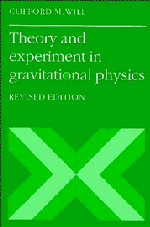Book contents
- Frontmatter
- Contents
- Preface to Revised Edition
- Preface to First Edition
- 1 Introduction
- 2 The Einstein Equivalence Principle and the Foundations of Gravitation Theory
- 3 Gravitation as a Geometric Phenomenon
- 4 The Parametrized Post-Newtonian Formalism
- 5 Post-Newtonian Limits of Alternative Metric Theories of Gravity
- 6 Equations of Motion in the PPN Formalism
- 7 The Classical Tests
- 8 Tests of the Strong Equivalence Principle
- 9 Other Tests of Post-Newtonian Gravity
- 10 Gravitational Radiation as a Tool for Testing Relativistic Gravity
- 11 Structure and Motion of Compact Objects in Alternative Theories of Gravity
- 12 The Binary Pulsar
- 13 Cosmological Tests
- 14 An Update
- References
- References to Chapter 14
- Index
11 - Structure and Motion of Compact Objects in Alternative Theories of Gravity
Published online by Cambridge University Press: 04 April 2011
- Frontmatter
- Contents
- Preface to Revised Edition
- Preface to First Edition
- 1 Introduction
- 2 The Einstein Equivalence Principle and the Foundations of Gravitation Theory
- 3 Gravitation as a Geometric Phenomenon
- 4 The Parametrized Post-Newtonian Formalism
- 5 Post-Newtonian Limits of Alternative Metric Theories of Gravity
- 6 Equations of Motion in the PPN Formalism
- 7 The Classical Tests
- 8 Tests of the Strong Equivalence Principle
- 9 Other Tests of Post-Newtonian Gravity
- 10 Gravitational Radiation as a Tool for Testing Relativistic Gravity
- 11 Structure and Motion of Compact Objects in Alternative Theories of Gravity
- 12 The Binary Pulsar
- 13 Cosmological Tests
- 14 An Update
- References
- References to Chapter 14
- Index
Summary
Within general relativity, the structure and motion of relativistic, condensed Objects–neutron stars and black holes–are subjects that have attracted enormous interest in the past two decades. The discovery of pulsars in 1967, and of the x-ray source Cygnus XI in 1971, have turned these “theoretical fantasies” into potentially viable denizens of the astrophysical zoo. However, relatively little attention has been paid to the study of these objects within alternative metric theories of gravity. There are two reasons for this. First, as potential testing grounds for theories of gravitation, the observations of neutron stars and black holes are generally thought to be weak, because of the large uncertainties in the nongravitational physics that is inextricably intertwined with the gravitational effects in the structure and interactions of such bodies. Examples are uncertainties in the equation of state for matter at neutronstar densities, and uncertainties in the detailed mechanisms for x-ray emission from the neighborhood of black holes. Second, compared with the simplicity of the post-Newtonian limits of alternative theories and the consequent availability of a PPN formalism, the equations for neutronstar structure and black hole structure are so complex in many theories, and so different from theory to theory, that no systematic study has been possible.
Neutron stars were first suggested as theoretical possibilities within general relativity in the 1930s (Baade and Zwicky, 1934). They are highly condensed stars where gravitational forces are sufficiently strong to crush atomic electrons together with the nuclear protons to form neutrons, raise the density of matter above nuclear density (ρ ∼ 3 x 1014 g cm-3), and cause the neutrons to be quantum-mechanically degenerate. A typical neutron-star model has m ≃ 1m☉, R ≃10 km.
- Type
- Chapter
- Information
- Theory and Experiment in Gravitational Physics , pp. 255 - 282Publisher: Cambridge University PressPrint publication year: 1993

